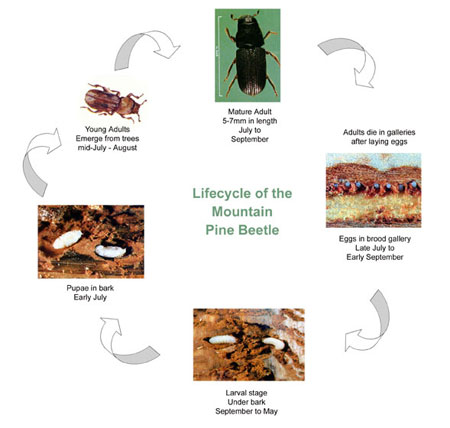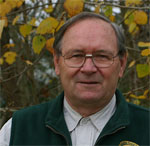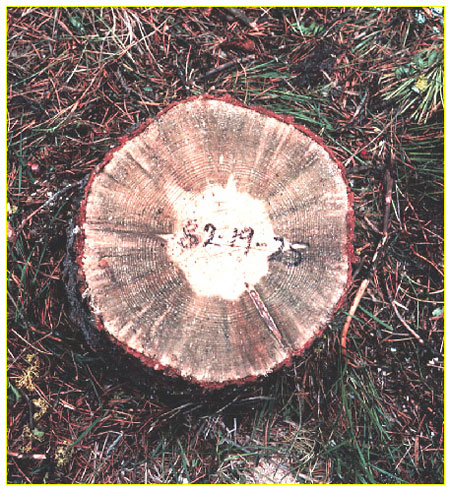A beetle's life
 |
 |

Dr. Les Safranyik of the Canadian Forest Service talks about the mountain pine beetle life cycle:
“The female beetle makes the attack upon finding a suitable host. She bores under the bark into the inner bark or the phloem region and starts constructing the egg gallery across the grain of the wood, and clearing the boring dust out of the gallery before mating. Following mating, the entrance hole will be plugged with boring dust and the female beetle starts laying eggs, usually about 60-80 eggs per egg gallery. The male, for at least a period of time, assists the female with packing boring dust down into the lower end of the egg gallery. Now the eggs are very small, less than one millimetre across, pearly white, and it will take under average conditions about two weeks to hatch. The eggs hatch into small legless grubs called larvae. They are usually translucent, pale coloured and c-shaped and they have little brown heads. They grow through five stages we call instars and usually before the winter sets in, the larvae grow to the last two stages called the 3rd and 4th larvae instar. These are the most cold hardy so overwintering takes place usually in the last two instar stages. Next spring, the larvae complete feeding and then construct what we called a pupal chamber to pupate. Now, the pupae is the resting stage. This is the stage where the internal organs of the larvae get reorganised into what eventually becomes an adult beetle. The pupal stage lasts, depending on temperature conditions, anywhere from two weeks up to a month; the pupae eventually metamorphose or turn into the adult stage.”
Not all life cycles are the same
Mountain pine beetles normally produce one generation a year. However, this can vary due to temperature and elevation. For example, warmer climates have been known to experience two generations a year, whereas colder climates may only experience one every two years.
Is that sawdust?
When beetles bore through the bark and dig galleries, they produce a type of sawdust called “frass”. Frass can be seen in the bark and on the ground below the boreholes.
 Frass on a lodgepole pine tree. Frass on a lodgepole pine tree.© Canadian Forest Service, Natural Resources Canada |
What is blue stain fungi?
Mountain pine beetle do not kill trees on their own. When adults bore into the host pine tree and dig out the galleries, the blue stain fungi they carry quickly kills living tree cells. By killing these cells, the fungi often prevent the tree from producing resin to defend itself against the beetle. This allows the adult beetles to successfully lay their eggs. When the eggs mature to pupae, they feed on the blue stain fungi, and in doing so cover their heads and mouth parts with it. The pupae then mature to adults, and by the time the new adults leave the tree, they carry enough fungi to infect the new host tree. Blue stain fungi give a blue-grey appearance to the sapwood.
 Tree stump infected with blue stain fungi. Tree stump infected with blue stain fungi.© Parks Canada |
To learn more about the blue stain fungi and other species.....
To learn more about how trees defend themselves against beetles......
Learn more about biology and outbreak development on this Canadian Forest Service web page.
- Date modified :
